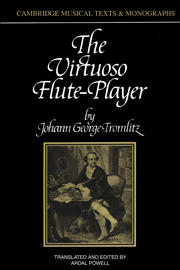Book contents
- Frontmatter
- Contents
- Translator's note
- Introduction by Eileen Hadidian
- Title in the series
- DETAILED AND THOROUGH TUTOR FOR PLAYING THE FLUTE
- Foreword
- Introduction
- 1 The flute and its character
- 2 Holding the flute, and the embouchure
- 3 Fingering
- 4 The notes and rests, their values and denominations, and the other musical signs
- 5 Time-signatures, and how the notes are divided and counted in them; the beat itself, or counting time according to an appointed tempo
- 6 Tone and pure intonation
- 7 Modern key-signatures
- 8 The articulation proper to this instrument, or the means of governing the wind suitably, as well in slow as in moderately quick movements; also called the single tongue
- 9 The technique for executing fast and very fast passages clearly and roundly; also, though improperly, called the ‘double tongue’
- 10 The ornaments
- 11 The trill
- 12 Fermatas and cadenzas
- 13 The taking of breath in flute-playing
- 14 The discretionary ornaments; or how to vary a simple melody according to the rules of harmony, and to use these variations in a good and suitable way appropriate to the material
- 15 Summary of the whole, together with a few remarks for pupils and masters
- Fingering-chart
- Select bibliography
- Index
3 - Fingering
Published online by Cambridge University Press: 01 June 2011
- Frontmatter
- Contents
- Translator's note
- Introduction by Eileen Hadidian
- Title in the series
- DETAILED AND THOROUGH TUTOR FOR PLAYING THE FLUTE
- Foreword
- Introduction
- 1 The flute and its character
- 2 Holding the flute, and the embouchure
- 3 Fingering
- 4 The notes and rests, their values and denominations, and the other musical signs
- 5 Time-signatures, and how the notes are divided and counted in them; the beat itself, or counting time according to an appointed tempo
- 6 Tone and pure intonation
- 7 Modern key-signatures
- 8 The articulation proper to this instrument, or the means of governing the wind suitably, as well in slow as in moderately quick movements; also called the single tongue
- 9 The technique for executing fast and very fast passages clearly and roundly; also, though improperly, called the ‘double tongue’
- 10 The ornaments
- 11 The trill
- 12 Fermatas and cadenzas
- 13 The taking of breath in flute-playing
- 14 The discretionary ornaments; or how to vary a simple melody according to the rules of harmony, and to use these variations in a good and suitable way appropriate to the material
- 15 Summary of the whole, together with a few remarks for pupils and masters
- Fingering-chart
- Select bibliography
- Index
Summary
One would think that there was not much more to be said on this subject; since once one has a fingering-chart, it ought to be enough to be going on with; but this is not true, although many people make do with this much. It would be feasible enough if all flutes were uniform in tuning, and a suitable and correct fingering-chart were available; however, since this is not the case, but each flute is tuned differently, a single system of fingering cannot be suitable for all flutes. It is not like the keyboard or the fiddle, which always use their usual fingerings whether the instrument is good or bad. On my flutes, where construction and tuning are quite in proportion with one another, there is likewise a firmly established and universally applicable system of fingering; but without one of these it is not possible to play in tune even on a correctly tuned flute.
Now since one is no good without the other, it is still not possible to play in tune even if one has a correctly tuned flute, without also having a fingering-chart suitable for it. A general fingering-chart that is supposed to work on all flutes cannot produce good results. Even my fingering-chart is not totally suitable for ordinary flutes, since it is contrived exclusively for my flutes, on which by means of this fingering system G♭ and F♯; B♭ and A♯; C♯ and D♭, and so on, may be distinguished.
- Type
- Chapter
- Information
- The Virtuoso Flute-Player , pp. 53 - 73Publisher: Cambridge University PressPrint publication year: 1991



